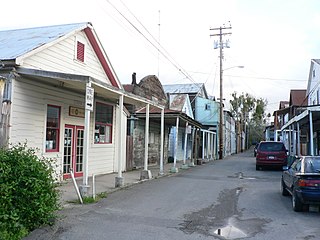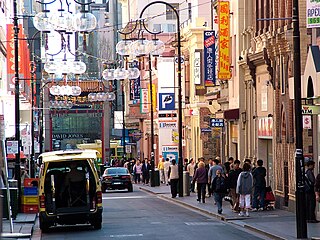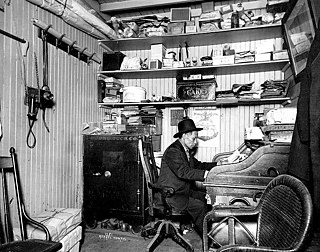
The Chinatown–International District of Seattle, Washington is the center of the city's Asian American community. Within the district are the three neighborhoods known as Chinatown, Japantown and Little Saigon, named for the concentration of businesses owned by people of Chinese, Japanese and Vietnamese descent, respectively. The geographic area also once included Manilatown.

Locke, also known as Locke Historic District, is an unincorporated community in the Sacramento–San Joaquin River Delta of California, United States. The 14-acre town (5.7 ha) was first developed between 1893 and 1915 approximately one mile north of the town of Walnut Grove in Sacramento County.

Wing Chong Luke was a Chinese-American lawyer and politician from Seattle.

The Museum of Chinese in America is a museum in New York City which exhibits Chinese American history. It is a nonprofit 501(c)(3) education and cultural institution that presents the living history, heritage, culture, and diverse experiences of Chinese Americans through exhibitions, educational services and public programs. Much of its collection was damaged or destroyed in a fire in January 2020. After being closed for more than a year following the fire, the museum reopened to the public on July 15, 2021.

Hing Hay Park is a 0.64-acre (2,600 m2) public park in the Chinatown–International District neighborhood of downtown Seattle, Washington, United States. The park is located on the north side of South King Street between 6th and Maynard avenues, east of Union Station and the Historic Chinatown Gate. It was built in 1973 and includes a pavilion, community games, and two gateways.
This is an alphabetical index of topics related to Asian Americans.

Chinatown is an ethnic enclave in the central business district (CBD) of Melbourne, Victoria, Australia. Centred at the eastern end of Little Bourke Street, it extends between the corners of Swanston and Spring streets, and consists of numerous laneways, alleys and arcades. Established in the 1850s during the Victorian gold rush, it is notable for being the longest continuous ethnic Chinese settlement in the Western World and the oldest Chinatown in the Southern Hemisphere.

The East Kong Yick Building is one of two buildings erected in Seattle, Washington's Chinatown-International District (ID) by the Kong Yick Investment Company. A four-story hotel in the core of the ID, with retail stores at ground level, the East Kong Yick was created by the pooled resources of 170 Chinese American pioneers. In, 2008, the building reopened as the home of the expanded Wing Luke Asian Museum.

Chin Gee Hee, courtesy name Chàngtíng (暢庭), Cheun Gee Yee, was a Chinese merchant, labor contractor, and railway entrepreneur, who made his fortune in Seattle, Washington before returning to his native village in Guangdong province, where he continued his successes.

Ron Chew is an American consultant and community organizer. Chew is a leader in the community based model of museum exhibit development. He lives in Seattle, Washington.

The Asian Pacific Thematic Historic District (APTHD), San Diego's historic Chinatown, is an eight-block district adjacent to and in part overlapping with the Gaslamp Quarter Historic District. The APTHD is bounded by Market Street on the north, 2nd Ave. on the west, 6th Ave. on the east and J St. on the south. 22 structures are considered historically contributing.

Chinatowns are enclaves of Chinese people outside of China. The first Chinatown in the United States was San Francisco's Chinatown in 1848, and many other Chinatowns were established in the 19th century by the Chinese diaspora on the West Coast. By 1875, Chinatowns had emerged in eastern cities such as New York City, Boston, Pittsburgh, and Philadelphia. The Chinese Exclusion Act of 1882 barred Chinese immigration to the United States, but the Magnuson Act of 1943 repealed it, and the population of Chinatowns began to rise again.

The Chinese American Museum of Chicago(CAMOC) seeks to advance the appreciation of Chinese American culture through exhibitions, education, and research and to preserve the past, present, and future of Chinese Americans primarily in the American Midwest. The museum opened in 2005 in Chicago's Chinatown neighborhood. Although it suffered a damaging fire in 2008, it reopened its renovated quarters, the Raymond B. & Jean T. Lee Center, in 2010. CAMOC is governed by the Board of Directors of the Chinatown Museum Foundation (CMF), a 501(C)(3) non-profit corporation located in Chicago, Illinois.
Asian Washingtonians are residents of the state of Washington who are of Asian ancestry. As of the 2010 U.S. Census, Asian-Americans were 7.7% of the state's population. As per the 2019 it’s 9-10%.
Tomie Arai is a public American artist, printmaker, and community activist living and working in New York City. Her works consist of temporary and permanent multimedia site-specific art pieces that deal with topics of gender, community, and racial identity, and are influenced by her Japanese heritage and the urban experience of living in New York. She is highly involved in community discourse, co-founding the Chinatown Art Brigade. Her work is nationally exhibited and can be found in the collections of the Library of Congress, the Bronx Museum of the Arts, the Japanese American National Museum, the Williams College Museum of Art, the Museum of Modern Art, and the Whitney Museum.

Greater Seattle has had a Chinese American community almost since its founding in 1851. Chinese workers arriving in the 1860s were welcomed, because the Seattle area was sparsely settled and workers were needed; within a few decades, however, newly arrived white settlers resented the Chinese workers, and there were several anti-Chinese riots as the whites attempted to expel the Chinese from the area. Chinese settlement persisted, with the immigrants settling in a well-defined Chinatown where they maintained their culture through family groups, associations, and churches. In the mid-20th century Chinese Americans joined with other immigrant groups to oppose racial discrimination. In 1962 a Chinese American became the first person of Asian ancestry to hold elective office in the state of Washington.

Midori Kono Thiel is a Japanese American calligrapher based in Seattle. She grew up on Maui. She received her bachelor of arts and master of fine arts from the University of California, Berkeley. She has exhibited at the De Young Museum, San Francisco; Tokyo Metropolitan Art Museum; Seattle Art Museum; Portland Art Museum; Henry Art Gallery, Seattle; Cheney Cowles Art Museum, Spokane; and the Wing Luke Museum of the Asian Pacific American Experience, Seattle.

The Oakland Asian Cultural Center, also referred to as the OACC, is an Oakland-based nonprofit cultural center that carries out Asian and Pacific Islander American arts and culture programs. It is located in the Pacific Renaissance Plaza in Oakland Chinatown, residing three blocks away from the 12th Street Civic Center BART station on Broadway.

Tai Tung is the oldest surviving Chinese restaurant in the International District of Seattle. It was opened in 1935 by an immigrant from Hong Kong. The restaurant is the subject of a 2015 documentary, A Taste of Home, and was a location for the 2020 film The Paper Tigers. The restaurant's cellar is said to be haunted by kuei (ghosts). It is known for being busy on Christmas Day, when most Seattle restaurants are closed.

Canton Alley is a historic alley between 7th and 8th Avenues South in Seattle's Chinatown–International District, in the United States.



















